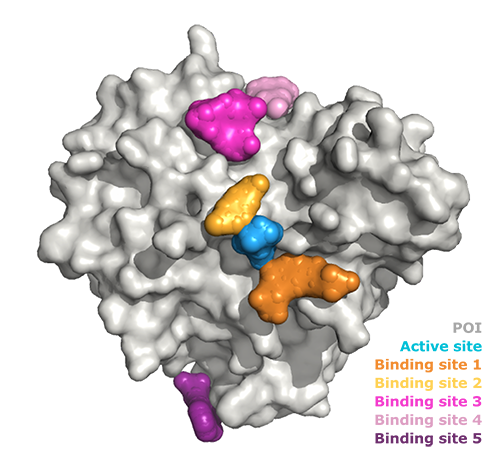


Tailored structural biology solutions to support diverse drug discovery approaches
Structural biology plays a crucial role in drug discovery and design, enabling a better understanding of structure-function relationships, validating hits, generating data that can solve or prevent optimization challenges, and supporting IND applications.
Our experienced structural biology team can support drug discovery projects from gene to structure, performing high-resolution structure determination for proteins, RNAs and complexes, including targets for which structures are typically challenging to elucidate.
De-risking drug discovery with structural data
Structural biology is integral to structure-based drug design and fragment-based drug design. However, structural biology services also play a crucial role in supporting and accelerating complimentary approaches such as ligand-based and AI/computer-aided drug design by enabling a better understanding of:
- Where a molecule binds
- Key interactions
- Potential growth vectors
Structural data can underpin and help drive your project at every step by:
- Validating experimental and virtual hits
- Selecting the best molecules for progression
- Guiding effective lead optimization and medicinal chemistry
- Troubleshooting optimization issues with potency and/or selectivity
- Strengthening publication submissions and IND filings
Structural biology services and assays
We have a comprehensive portfolio of structural biology services and assays available on-site, enabling us to design and implement a truly optimized approach.
Your project will be analyzed and risk-assessed by our experienced structural biologists and early drug discovery experts. We will then discuss with you and recommend a course of action that best aligns with your criteria, goals, and target. Factors that can influence approach include the nature of the target, its dynamic properties (such as disordered regions) or its conformational flexibility, the affinity of interactions, and the level of detail and throughput required.
Structural biology services include:
- X-ray Crystallography: Protein crystallography remains the gold standard for high-resolution structural information to directly guide medicinal chemistry optimization. By combining in-house developments and customizations that augment our industry standard instrumentation, we support high-throughput soaking and co-crystallization campaigns for both reversible and covalent small-molecules.
- Protein- and RNA-Observed Nuclear Magnetic Resonance (NMR): NMR enables the study of protein (or RNA) structures and interactions in solution. Unlike other structural methods, NMR can provide structural information at increasing resolution. The binding site of a compound can be readily mapped by evaluating selective perturbations in the NMR spectrum of the protein. When needed, the 3D structure of the target (alone or in complex with the molecule) can be elucidated by NMR. While being especially sensitive to weak interactions as often encountered early in a drug discovery campaign, NMR can also provide valuable structural constraints for high-affinity compounds, including covalent interactions.
- Cryo-electron Microscopy (Cryo-EM): Cryo-EM excels at providing structural insights into large proteins and protein complexes. With recent developments pushing resolution to near-atomic levels, cryo-EM structures now offer the level of detail needed to support medicinal chemistry efforts. Cryo-EM is particularly well suited to support the development of proximity-inducing small-molecules, such as molecular glues or PROTACs, enabling the structure determination of ternary complexes (i.e., the complex between the target protein, the effector protein and the proximity-inducing small-molecule).
| X-ray Crystallography | Nuclear Magnetic Resonance | Cryo-EM | |
| Resolution | Atomic | Moderate to high | Near-atomic |
| Structural information type | Static, high-resolution snapshot | Dynamic, in-solution behavior; structural ensembles possible | Static but representative of native-like conformations |
| Throughput | High | High for binding site mapping
Moderate for structure determination |
Moderate |
| Best suited for (typically) | Small to medium-sized proteins; stable and crystallizable targets | Small sized proteins and RNAs, flexible or hard-to-crystallize targets | Large proteins, complexes, membrane proteins, flexible or hard-to-crystallize targets |
| Key strengths | Detailed data to guide medicinal chemistry and structure-based design | Hit validation in solution
Provides interaction insights in more physiologically relevant conditions |
Ideal for large, flexible complexes and novel modalities (e.g., PROTACs, molecular glues).
Low sample consumption |
| Limiting factors | Requires crystallization and moderate-to-high sample consumption
Less suited to large multi-protein complexes |
Requires protein labeled with stable isotopes (15N, 13C) and moderate-to-high sample consumption
Less suited to large proteins or complexes (>50 kDa) |
Not well suited to small to medium sized proteins (<100 kDa) |
Related services and assays
Successful structural biology campaigns are built from high quality protein and well validated interactions. Our structural biology services are supported by:
- Protein expression and purification from E. coli and mammalian cells
- Characterization of protein and protein complexes
- Binding and competition assays
- Ligand-Observed, Protein-Observed, RNA-Observed, and Target-Immobilized NMR
- Surface Plasmon Resonance (SPR)
- Thermal Shift (including nanoDSF and DLS)

Partnering with our structural biology team
We treat every drug discovery project as unique. Our integrated approach ensures seamless collaboration, and we prioritize rigorous quality checks before assays, ensuring the integrity of every step.
By collaborating with our Structural Biology team, you gain access to the full breadth of our early discovery expertise. Our integrated approach means all teams work closely together to support your project. Structural Biology partners with the Protein Science group to ensure the use of optimal protein constructs for successful structure elucidation. The Assay Development & Screening team designs and runs the most effective assays for identifying the right molecules to be tested in structural studies. In parallel, our Chemistry team can guide the design of new compounds that improve interactions with your target, based on both assay data and structural insights. This cross-functional synergy ensures every aspect of your project is strategically aligned for success.
Nimble Experiment Management: Our team is flexible, proactive, and quick to communicate and take action if an experiment isn’t progressing as expected. If results differ from expectations, we will work closely with you to understand the outcomes, and to plan the next steps.
Deliverables: In addition to PDB structures, deliverables include raw data, full analysis, and reporting. Optionally, we can also support publications and patent applications. We have a comprehensive suite of biophysics services that complement our structural biology workflows and assist with structure validation, enabling immediate progression once you have structural data in-hand.
When you partner with the Oncodesign-ZoBio team you will receive customized, high-quality research designed specifically for your needs. Contact our team today to learn more about our structural biology services.



